Imagine the most elaborate craftsmanship, a blend of exclusive materials never seen before in the automotive sector mixed with the sharpest focus on the smallest detail. Then picture the passion of an Italian specialty automaker and the expertise of an Argentinean designer, previously employed by Lamborghini as a composite specialist. Combine all these ingredients and you will get a brand often referred to as the most exclusive supercar maker in the world; Pagani. The Italian car maker has already left its mark on the hypercar world with the highly-acclaimed Zonda and all its consecutive model variants. More recently, they reaffirmed this status with the outrageous record-breaking Zonda R.
Twelve years after the official debut of the Zonda at the Geneva Auto Salon, owner Horacio Pagani pulled the covers off its successor, the 2012 Pagani Huayra hypercar (pronounced wai-rah) at this year’s Geneva Motor Show. Named after Aymara Huayra Tata, the Argentinean god of wind, who controls the breezes, the winds and the hurricanes that affect the mountains, ravines and slopes of the Andean Cordillera, it merges the past, present and future in a timeless interpretation of automotive art with the utmost precision.
The styling of the Huayra was perfected over the course of five years. Each line has a clear beginning and an equally clear purpose. During the development, eight scale models were created, as well as two 1:1 models, each an evolution of the previous in a perpetual quest to perfect the form and refine the substance. Just as Mr. Pagani envisaged his creation. And now it’s there, available for interested customers around the whole world, a first ever in the young history of the Italian car builder, and we had an exclusive ride in it!
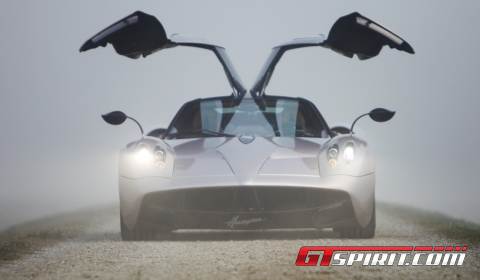
The central piece of the art is an all-new carbon-titanium monocoque. The composite construction offers the platform of the supercar. It combines the highest levels of rigidity with maximum lightness. At both sides of the tub semi-chrome-moly subframes have been fitted to offer an exceptional rigidity-to-weight ratio. These cradle numerous technical parts and the push-rod suspension. The constant quest for perfection has created a setup ensuring the best possible protection in case of an impact yet with a weight of less than 1,350kg making Huayra the lightest sports car in its class.
Many of the techniques developed for the Zonda R track-day supercar were used in the Huayra‘s construction. The Zonda R acted as a test-bed for the Huayra. The push-rod suspension with adjustable Öhlins shock absorbers are a clear example of this. The individual suspension made with forged AvionAl double A-arms has been tested extensively and the geometry has been designed to further enhance the levels of confidence already present in the Zonda on the longer wheelbase Huayra.
The bespoke Pirelli P Zero tires fitted to the Huayra are one-of-a-kind. They are built in a dedicated MIRS (Modular Integrated Robotized System) facility, dedicated to the production of ultrahigh performance tires and are at the forefront of what is technically possible, suited to top speeds above 370km/h as well as to lateral forces exceeding 1,5 G. Another example of attention to detail, not often heard of in the world of supercars.
MIRS is the most advanced robotized tyre manufacturing system currently available, designed and developed entirely by Pirelli Group for the production of UHP tyres. Launched in 2000, MIRS is highly automated and controlled by integrated software whose great flexibility makes it ideally suited to a variety of markets, especially in countries where high labour costs are critical. Integration of all manufacturing stages cuts average construction time from raw materials to the warehouse by about 72 minutes. MIRS is already in use in Pirelli plants at Breuberg (Germany), Burton on Trent (UK) and Rome (Georgia, USA). Settimo Torinese—the Group’s most technologically advanced facility—is equipped with NEXT MIRS, an evolution of the MIRS system that offers even greater flexibility and efficiency.
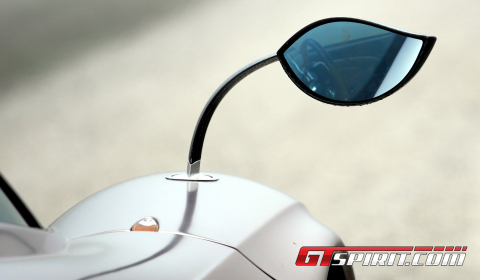
The pounding heart of the Argentinean god is called the M158. It is a twelve cylinder biturbo engine sourced from Mercedes-Benz and developed together with the Germans to meet not only the technical application, but also the strictest quality aspects. Its dual character became directly visible during our ride through the Italian landscape. Its harmonious levels of performance can be felt by the car’s immediate response to the slightest throttle input. The twin-turbos and waste gates are fitted at ear height and come into play when you request the Huayra to lift off and control the flow of air for its own advantage.
The V12 power plant produces an astonishing 700hp and 1,000Nm of maximum torque converted to the rear wheels via a transverse sequential seven-speed gearbox with a dual plate clutch in favor over a dual-clutch system which proved to be 70kg heavier. The gearbox is controlled via the paddle shifters behind the steering wheel or through a central-mounted gear lever, which offers you the mechanical experience of a normal manual stick.
The sound track of the engine is specifically tuned to match the wishes of its creator. A harmonic rumble at idle speeds with a hint of the power lies hidden at low speeds and a deep thunderous growl of motor and air, reminiscent of an airplane, at high speeds. This unique combination of sounds is the key characteristic to the Huayra.
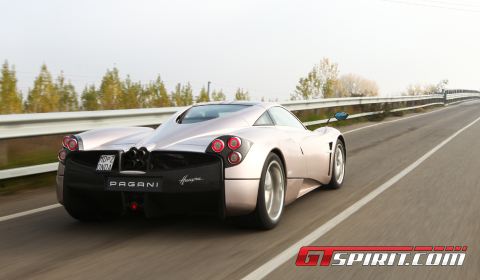
Our ride started at the Pagani factory in San Cesario sul Panaro near Modena, Italy and brought us to our destination in the heart of the Emilia-Romagna region. The early Saturday morning was filled with the mystique of fog surrounding the god of wind for the duration of its journey. As soon as the wing doors were closed we were in a world of emotion, mind-bending accelerations, air sucking turbos and surrounded by Pagani’s state of the art interior refinement.
In front of the driver a cluster of dials offer all the information needed to launch the Huayra. The center console is machined from a single block of anticorodal and inspired by the keys of a clarinet, with push buttons for controlling the heating and air conditioning. It includes the multimedia system with touchscreen control, audio functions and Bluetooth connectivity. The choice of background color for the buttons is not our personal highlight, but is immediately forgotten when the miniature Huayra-shaped key is turned and the turbocharged V12 engine erupts into life.
The first meters inside the hypercar feel sporty, not overly comfort, but sophisticated and light-footed. The immense power delivery is linear and progressive. The experience is accompanied by a mix of sounds coming from the tires, the wind finding its way passed the sleek lines of the supercar and a distinct dual-tone whistle from the turbo boost. This begins to build followed by a louder, more intense, whistle upon full boost and an ecstatic noise from the waste gates at throttle release.
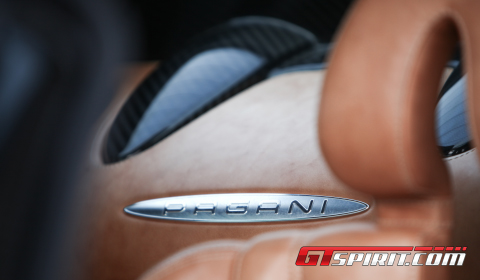
The four flaps placed at the ends of the bodywork actively and independently change the angle of attack for the wing-shaped supercar. They constantly react to changing driver inputs and vehicle conditions. The result is a machine that constantly changes its shape to ensure the minimum friction coefficient and the maximum down force. A special command unit receives and processes information about speed, yaw rate, lateral acceleration, steering angle and throttle position, and acts so as to sustain neutral behavior in all conditions, the correct aerodynamic roll and braking.
During braking, for example, the rear flaps and the front suspension raises to counteract the weight transfer. This evens the weight distribution between front and rear axles, allowing a better use of the rear brake force. The side air intakes behind the front wheels generate negative pressure inside the wheel, causing a draw that effectively lowers the coefficient of aerodynamic drag. The shape of the two engine air intakes is a tribute to the most advanced supersonic aircraft of the ’50s and ’60s.
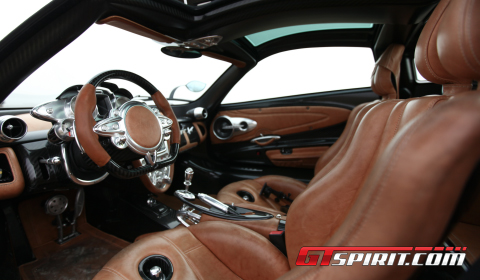
The brand new Pagani Huayra is more than a supercar, it is a piece of art created by a man who created his dream. Our first experience with Pagani’s creation is hardly one we will ever forget. In every single way it is so much more than just a supercar. The constant focus on the smallest of details is astonishing. Let Horacio Pagani explain to you the sheer detail of his team’s workmanship, and you will start to admire Huayra’s inner beauty and technical drive for precision.
The future for Pagani looks bright. The order book is filled for at least two years, the Asian and US markets are keen to receive the new hypercar and the first production model of the Huayra is planned to leave the factory before the end of this year. First road tests start after the Geneva Auto Salon in March where two new exterior and interior trims will be released to the public.

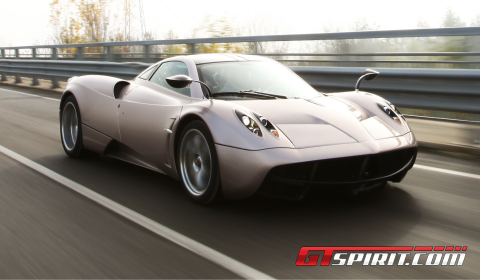



















































I wanna be in all the test drive commercials, fly me out and back. I am ready, let me shing this year and do the shows your man Nor4ton Blackie
the interior is nice
incredible car… shame about those horrible wing mirrors haha :( if i was buying one id ask if i could design some differently, less feminine and catty, they’d probably refuse to sell me one.